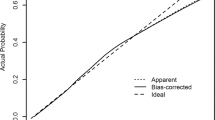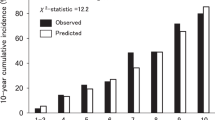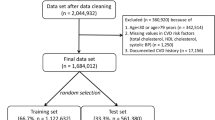Abstract
This study aimed to develop and validate the hypertension risk prediction models of the CArdioVascular disease Association Study (CAVAS). Overall, 6,186 participants without hypertension at baseline were randomly divided into derivation and internal validation sets in a 6:4 ratio. We derived two prediction models: the first used the Framingham hypertension risk prediction factors (F-CAVAS-HTN); the second considered additional risk factors identified using stepwise Weibull regression analysis (CAVAS-HTN). These models were externally evaluated among Ansan and Ansung (A&A) participants, and the external validity of the Framingham and A&A prediction models (F-HTN and A&A-HTN) were assessed using the internal validation set of CAVAS. The discrimination, calibration, and net reclassification were determined. During the 4-year follow-up, 777 new cases of hypertension were diagnosed. All four models showed good discrimination (C-statistic ≥ 0.7). Internal calibrations were good for both the coefficient-based and the risk score-based F-CAVAS-HTN models, respectively (Hosmer-Lemeshow chi-square, H-L χ2 < 20, P ≥ 0.05). However, the two CAVAS models (H-L χ2 ≥ 20, P < 0.05, both) as well as the F-HTN and the A&A-HTN prediction models (H-L χ2 = 155.39, P < 0.0001; H-L χ2 = 209.72, P < 0.0001, respectively) were not externally calibrated. The F-CAVAS-HTN may be better than models with additional risk factors or derived for another population in the view of the findings of the internal validation in the present study, although future studies to improve the external validity of the F-CAVAS-HTN are needed.
This is a preview of subscription content, access via your institution
Access options
Subscribe to this journal
Receive 12 digital issues and online access to articles
$119.00 per year
only $9.92 per issue
Buy this article
- Purchase on Springer Link
- Instant access to full article PDF
Prices may be subject to local taxes which are calculated during checkout

Similar content being viewed by others
References
Forouzanfar MH, Liu P, Roth GA, Ng M, Biryukov S, Marczak L, et al. Global Burden of Hypertension and Systolic Blood Pressure of at Least 110 to 115 mmHg, 1990-2015. JAMA. 2017;317:165–82.
Collaborators GBDRF. Global, regional, and national comparative risk assessment of 84 behavioural, environmental and occupational, and metabolic risks or clusters of risks, 1990–2016: a systematic analysis for the Global Burden of Disease Study 2016. Lancet. 2017;390:1345–422.
Norris KC, Beech BM. Blood pressure and hypertension management. In: ASPC Manual of preventive cardiology. Springer, 2021, pp 201-25.
Lim GB. Low sodium and DASH diet to lower blood pressure. Nat Rev Cardiol. 2018;15:68–68.
Whelton PK, Carey RM, Aronow WS, Casey DE, Collins KJ, Himmelfarb CD, et al. 2017 ACC/AHA/AAPA/ABC/ACPM/AGS/APhA/ASH/ASPC/NMA/PCNA guideline for the prevention, detection, evaluation, and management of high blood pressure in adults. J Am Coll Cardiol. 2018;71:e127–e248.
Parikh NI, Pencina MJ, Wang TJ, Benjamin EJ, Lanier KJ, Levy D, et al. A risk score for predicting near-term incidence of hypertension. Ann Intern Med. 2008;148:102–10.
Paynter NP, Cook NR, Everett BM, Sesso HD, Buring JE, Ridker PM. Prediction of incident hypertension risk in women with currently normal blood pressure. Am J Med. 2009;122:464–71.
Kshirsagar AV, Chiu YL, Bomback AS, August PA, Viera AJ, Colindres RE, et al. A hypertension risk score for middle-aged and older adults. J Clin Hypertens. 2010;12:800–8.
Bozorgmanesh M, Hadaegh F, Mehrabi Y, Azizi F. A point-score system superior to blood pressure measures alone for predicting incident hypertension: Tehran Lipid and Glucose Study. J Hypertens. 2011;29:1486–93.
Chien KL, Hsu HC, Su TC, Chang WT, Sung FC, Chen MF, et al. Prediction models for the risk of new-onset hypertension in ethnic Chinese in Taiwan. J Hum Hypertens. 2011;25:294–303.
Fava C, Sjogren M, Montagnana M, Danese E, Almgren P, Engstrom G, et al. Prediction of blood pressure changes over time and incidence of hypertension by a genetic risk score in Swedes. Hypertension. 2013;61:319–26.
Otsuka T, Kachi Y, Takada H, Kato K, Kodani E, Ibuki C, et al. Development of a risk prediction model for incident hypertension in a working-age Japanese male population. Hypertens Res. 2015;38:419–25.
Chen Y, Wang C, Liu Y, Yuan Z, Zhang W, Li X, et al. Incident hypertension and its prediction model in a prospective northern urban Han Chinese cohort study. J Hum Hypertens. 2016;30:794–800.
Wang B, Liu Y, Sun X, Yin Z, Li H, Ren Y, et al. Prediction model and assessment of probability of incident hypertension: the Rural Chinese Cohort Study. J Hum Hypertens. 2021;35:74–84.
Kivimaki M, Batty GD, Singh-Manoux A, Ferrie JE, Tabak AG, Jokela M, et al. Validating the Framingham Hypertension Risk Score: results from the Whitehall II study. Hypertension. 2009;54:496–501.
Kivimaki M, Tabak AG, Batty GD, Ferrie JE, Nabi H, Marmot MG, et al. Incremental predictive value of adding past blood pressure measurements to the Framingham hypertension risk equation: the Whitehall II Study. Hypertension. 2010;55:1058–62.
Muntner P, Woodward M, Mann DM, Shimbo D, Michos ED, Blumenthal RS, et al. Comparison of the Framingham Heart Study hypertension model with blood pressure alone in the prediction of risk of hypertension: the Multi-Ethnic Study of Atherosclerosis. Hypertension. 2010;55:1339–45.
Lim NK, Son KH, Lee KS, Park HY, Cho MC. Predicting the risk of incident hypertension in a Korean middle-aged population: Korean genome and epidemiology study. J Clin Hypertens. 2013;15:344–9.
Carson AP, Lewis CE, Jacobs DR Jr., Peralta CA, Steffen LM, Bower JK, et al. Evaluating the Framingham hypertension risk prediction model in young adults: the Coronary Artery Risk Development in Young Adults (CARDIA) study. Hypertension. 2013;62:1015–20.
Zheng L, Sun Z, Zhang X, Li J, Hu D, Chen J, et al. Predictive value for the rural Chinese population of the Framingham hypertension risk model: results from Liaoning Province. Am J Hypertens. 2014;27:409–14.
Lewington S, Clarke R, Qizilbash N, Peto R, Collins R. Age-specific relevance of usual blood pressure to vascular mortality: a meta-analysis of individual data for one million adults in 61 prospective studies. Lancet. 2002;360:1903–13.
Chobanian AV, Bakris GL, Black HR, Cushman WC, Green LA, Izzo JL Jr., et al. The seventh report of the Joint National Committee on Prevention, Detection, Evaluation, and Treatment of High Blood Pressure: the JNC 7 report. JAMA. 2003;289:2560–72.
Kshirsagar AV, Carpenter M, Bang H, Wyatt SB, Colindres RE. Blood pressure usually considered normal is associated with an elevated risk of cardiovascular disease. Am J Med. 2006;119:133–41.
James PA, Oparil S, Carter BL, Cushman WC, Dennison-Himmelfarb C, Handler J, et al. 2014 evidence-based guideline for the management of high blood pressure in adults: report from the panel members appointed to the Eighth Joint National Committee (JNC 8). JAMA. 2014;311:507–20.
Kim Y, Han BG. Cohort Profile: The Korean Genome and Epidemiology Study (KoGES) Consortium. Int J Epidemiol. 2017;46:e20.
Riley RD, Snell KI, Ensor J, Burke DL, Harrell FE Jr, Moons KG, et al. Minimum sample size for developing a multivariable prediction model: PART II‐binary and time‐to‐event outcomes. Stat Med. 2019;38:1276–96.
Friedewald WT, Levy RI, Fredrickson DS. Estimation of the concentration of low-density lipoprotein cholesterol in plasma, without use of the preparative ultracentrifuge. Clin Chem. 1972;18:499–502.
Lim NK, Lee JW, Park HY. Validation of the Korean Genome Epidemiology Study Risk Score to Predict Incident Hypertension in a Large Nationwide Korean Cohort. Circ J. 2016;80:1578–82.
D’Agostino RB Sr, Grundy S, Sullivan LM, Wilson P, Group ftCRP. Validation of the Framingham Coronary Heart Disease Prediction Scores: results of a multiple ethnic groups investigation. JAMA. 2001;286:180–7.
Sullivan LM, Massaro JM, D’Agostino RB Sr. Presentation of multivariate data for clinical use: the Framingham Study risk score functions. Stat Med. 2004;23:1631–60.
Cook NR. Use and misuse of the receiver operating characteristic curve in risk prediction. Circulation. 2007;115:928–35.
Woodward M. Epidemiology: study design and data analysis, Chapman and Hall/CRC, 2013.
Pencina MJ, D’Agostino RB Sr., D’Agostino RB Jr., Vasan RS. Evaluating the added predictive ability of a new marker: from area under the ROC curve to reclassification and beyond. Stat Med. 2008;27:157–72. discussion 207–12
Fuchs FD, Chambless LE, Whelton PK, Nieto FJ, Heiss G. Alcohol consumption and the incidence of hypertension: the Atherosclerosis Risk in Communities Study. Hypertension. 2001;37:1242–50.
Huai P, Xun H, Reilly KH, Wang Y, Ma W, Xi B. Physical activity and risk of hypertension: a meta-analysis of prospective cohort studies. Hypertension. 2013;62:1021–6.
Halperin RO, Sesso HD, Ma J, Buring JE, Stampfer MJ, Michael Gaziano J. Dyslipidemia and the risk of incident hypertension in men. Hypertension. 2006;47:45–50.
Kasahara A, Adachi H, Hirai Y, Enomoto M, Fukami A, Yoshikawa K, et al. High level of plasma remnant-like particle cholesterol may predispose to development of hypertension in normotensive subjects. Am J Hypertens. 2013;26:793–8.
Nordestgaard BG, Varbo A. Triglycerides and cardiovascular disease. Lancet. 2014;384:626–35.
Gillis EE, Sullivan JC. Sex differences in hypertension: recent advances. Hypertension. 2016;68:1322–7.
Choi HM, Kim HC, Kang DR. Sex differences in hypertension prevalence and control: analysis of the 2010-4 Korea National Health and Nutrition Examination Survey. PloS One. 2017;12:e0178334.
Niskanen L, Laaksonen DE, Nyyssonen K, Punnonen K, Valkonen VP, Fuentes R, et al. Inflammation, abdominal obesity, and smoking as predictors of hypertension. Hypertension. 2004;44:859–65.
Kim HJ, Kim Y, Cho Y, Jun B, Oh KW. Trends in the prevalence of major cardiovascular disease risk factors among Korean adults: results from the Korea National Health and Nutrition Examination Survey, 1998–2012. Int J Cardiol. 2014;174:64–72.
Chang Y, Kang H-Y, Lim D, Cho H-J, Khang Y-H. Long-term trends in smoking prevalence and its socioeconomic inequalities in Korea, 1992–2016. Int J Equity Health. 2019;18:1–10.
KCDC, Welfare MoHa. 2013 National Health Statistics: Korea National Health and Nutrition Examination Survey (KNHANES). 2014.
KCDC, Welfare MoHa. 2018 National Health Statistics: National Health and Nutrition Examination Survey (KNHANES). 2019.
Guzder RN, Gatling W, Mullee MA, Mehta RL, Byrne CD. Prognostic value of the Framingham cardiovascular risk equation and the UKPDS risk engine for coronary heart disease in newly diagnosed Type 2 diabetes: results from a United Kingdom study. Diabet Med. 2005;22:554–62.
Shih P-aB, O’Connor DT. Hereditary determinants of human hypertension: strategies in the setting of genetic complexity. Hypertension. 2008;51:1456–64.
Kim YK, Kim Y, Hwang MY, Shimokawa K, Won S, Kato N, et al. Identification of a genetic variant at 2q12. 1 associated with blood pressure in East-Asians by genome-wide scan including gene-environment interactions. BMC Med Genet. 2014;15:65.
Kim MK, Kim K, Shin M-H, Shin DH, Lee Y-H, Chun B-Y, et al. The relationship of dietary sodium, potassium, fruits, and vegetables intake with blood pressure among Korean adults aged 40 and older. Nutr Res Pract. 2014;8:453–62.
Acknowledgements
This work was supported by the Research Program funded by the Korea Centers for Disease Control and Prevention (2004-E71004-00, 2005-E71011-00, 2006-E71009-00, 2007-E71002-00, 2008-E71004-00, 2009-E71006-00, 2010-E71003-00, 2011-E71002-00, 2012-E71007-00, 2013-E71008-00, 2014-E71006-00, 2014-E71006-01, 2016-E71001-00, 2017N-E71001-00) and was supported by a National Research Foundation of Korea (NRF) grant funded by the Korean government (MSIT) (No. NRF-2019R1H1A2079966).
Author information
Authors and Affiliations
Contributions
Hyun Kyung Namgung and Hye Won Woo have contributed equally to this work. Writing—original draft: HKN, HWW, MKK. Formal analysis: HKN, HWW. Methodology: HKN, HWW, JS, MKK. Supervision: MKK, YMK. Funding acquisition: HCK, SBK, MHS, MKK. Investigation: HKN, HWW, HCK, SBK, MHS, YMK, MKK. Writing - review and editing: HWW, MKK.
Corresponding authors
Ethics declarations
Competing interests
The authors declare no competing interests.
Additional information
Publisher’s note Springer Nature remains neutral with regard to jurisdictional claims in published maps and institutional affiliations.
Supplementary information
Rights and permissions
About this article
Cite this article
Namgung, H.K., Woo, H.W., Shin, J. et al. Development and validation of hypertension prediction models: The Korean Genome and Epidemiology Study_Cardiovascular Disease Association Study (KoGES_CAVAS). J Hum Hypertens 37, 205–212 (2023). https://doi.org/10.1038/s41371-021-00645-x
Received:
Revised:
Accepted:
Published:
Issue Date:
DOI: https://doi.org/10.1038/s41371-021-00645-x
This article is cited by
-
Development of risk models of incident hypertension using machine learning on the HUNT study data
Scientific Reports (2024)



